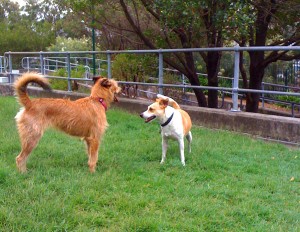
Hello all, in this blog we will take a look at how dogs communicate and hopefully give you some idea about how good (in their own way) they are at it.
Dogs communicate in four ways, those being Olfactory (smells), Auditory (hearing), Visual and Tactile (touch). I would not be able to cover all these in this one blog so we will have a look at arguably the most important (to a dog) of these, Olfactory communication. I will look at the other forms of canine communication in future blogs.
A dog has evolved to be an expert at Olfactory communication, the dogs nose is an incredible tool, lets have a few facts about that nose first.
A dogs nose can have a Olfactory epithelium (internal nose area) of between 20-200 sq cm depending on breed, we as humans have 2-4 sq cm.
They can have up to 250 Mio (million) scent receptor cells, we have 5 Mio.
Dogs noses are 1-100 Mio more sensitive to Butyric acid (in sweat), so good for tracking, it is estimated that the sweat left in a shoe print is 1 Mio more than threshold.
The area of a dogs brain used to analyse smells is 40 times larger than ours.
So with a nose like this it is somewhat obvious that olfactory communication is very important to the dog.
The dog also has several glands around its body that secrete scents and pheromone messages for others to find.
You will most probably have seen your dog stopping to sniff something when out and about followed closely by some salivating and then their behaviour becomes more intense sometimes to the extent of squealing and rushing around. What has just happened is your dog has found an interesting message, sometimes a long term message, left by another dog, on closer inspection they have licked the scent to transport it to the vomeronasal organ (or Jacobsons organ) found in the roof of your dogs mouth. This organ contains chemo receptors that are connected to the limbic system which is connected to emotional responses, hence the excited behaviour at what they have found. They will lick what they have found, salivate and then become excited about what they have found. What they did indeed find is a chemical message left by another dog from scent or pheromones excreted by that dog.

Glands that excrete these messages are found throughout your dog, on the side of the head (why they rub their head on smelly things), at the base of the tail called the Supracaudal or violet gland, on either side of the anus (anal glands), on the perineum (between the dogs legs) and between the toes which is why some dogs will scrape the ground after urinating to leave an additional pheromone message from these glands and a visual one from the scraped up ground too (a three fold message).
A dogs urine carries with in it a wealth of information for another dog to find. It can tell a dog the sex, age, status, health, breeding cycle (bitches), nutrition (proteins etc) and most importantly and very accurately how long ago another dog was there and if recently may well give the dog doing the smelling advance warning of something good (female in season) or bad (high status known aggressive dog) in the area, which will provoke a response be it disappearing over the horizon in search of the dog in season or being on guard in case of a meeting with the aggressive dog.
When your dog moves through the environment they are continually scenting the ground and air to pick up on these messages left by others, some are better at it than others (bloodhound for instance), but all are experts at it compared to us, we do not have the tools to do it but to a dog it is a major part of their makeup and way of life and you should allow your dog to carry out these behaviours as it is in my opinion intrinsically linked to a dogs well being, if they want to have a sniff and a pee then let them (if safe of course), olfactory and the other forms of canine communication and the need to carry it out will help with the socialisation of your dog as through experience they will be better at communicating with others.
I hope this has given you a brief but informative look at one of the forms of canine communication, it’s importance to your dog and hopefully a desire to find out more. For a more in depth look at all canine communication have a look at my website, it’s free, have a good day !
Blog by dogways.info

